Themed collection Frontiers in Molecular Simulation of Solvated Ions, Molecules and Interfaces

Frontiers in molecular simulation of solvated ions, molecules and interfaces
This themed collection is a collection of articles on frontiers in molecular simulation of solvated ions, molecules and interfaces.
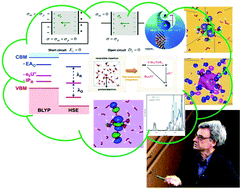
Phys. Chem. Chem. Phys., 2020,22, 10393-10396
https://doi.org/10.1039/D0CP90091E
Tumbling with a limp: local asymmetry in water's hydrogen bond network and its consequences
Ab initio molecular dynamics simulations of ambient liquid water and energy decomposition analysis have recently shown that water molecules exhibit significant asymmetry between the strengths of the two donor and/or the two acceptor interactions.
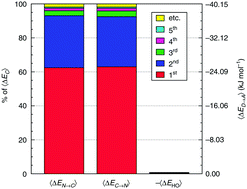
Phys. Chem. Chem. Phys., 2020,22, 10397-10411
https://doi.org/10.1039/C9CP06960G
DFT modelling of explicit solid–solid interfaces in batteries: methods and challenges
Density Functional Theory (DFT) calculations of electrode material properties in high energy density storage devices like lithium batteries have been standard practice for decades.
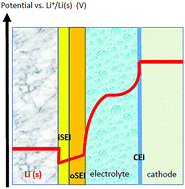
Phys. Chem. Chem. Phys., 2020,22, 10412-10425
https://doi.org/10.1039/C9CP06485K
Temperature effects on the ionic conductivity in concentrated alkaline electrolyte solutions
Reactive molecular dynamics simulations show how ion-paring, cross-correlated ion motions and proton transfer contribute to the ionic conductivity in concentrated NaOH solutions at elevated temperatures.
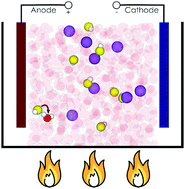
Phys. Chem. Chem. Phys., 2020,22, 10426-10430
https://doi.org/10.1039/C9CP06479F
Raman spectrum and polarizability of liquid water from deep neural networks
Using deep neural networks to model the polarizability and potential energy surfaces, we compute the Raman spectrum of liquid water at several temperatures with ab initio molecular dynamics accuracy.
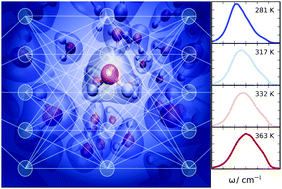
Phys. Chem. Chem. Phys., 2020,22, 10592-10602
https://doi.org/10.1039/D0CP01893G
Operando XANES from first-principles and its application to iridium oxide
Density-functional theory calculations augmented with a continuum description of the electrochemical environment are implemented to simulated X-ray absorption spectra as a function of the applied potential.
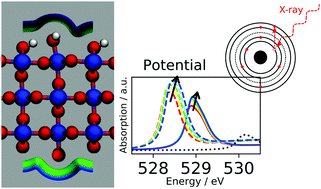
Phys. Chem. Chem. Phys., 2020,22, 10807-10818
https://doi.org/10.1039/C9CP06726D
DFT insights into electrocatalytic CO2 reduction to methanol on α-Fe2O3(0001) surfaces
Electrocatalytic reduction of CO2 to manufacture fuels and other useful chemicals is one of the appealing methods to reuse CO2.
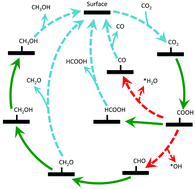
Phys. Chem. Chem. Phys., 2020,22, 10819-10827
https://doi.org/10.1039/C9CP06453B
Correlation effects in parallel tempering and the role of the swapping frequency
In this work I investigate the effect of the swapping time frequency in parallel tempering (or replica exchange molecular dynamics, REMD) on the sampled equilibrium distributions at the different temperatures.
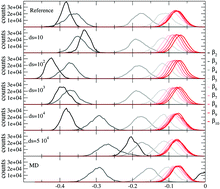
Phys. Chem. Chem. Phys., 2020,22, 10802-10806
https://doi.org/10.1039/C9CP06772H
Temperature effects on the spatial distribution of electrolyte mixtures at the aqueous liquid–vapor interface
Monte Carlo simulations indicate that an anion's propensity for interfacial adsorption increases with its size and is associated with an enthalpic gain and entropic cost for the largest anion.
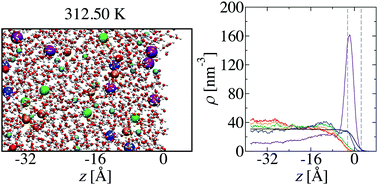
Phys. Chem. Chem. Phys., 2020,22, 10792-10801
https://doi.org/10.1039/C9CP06729A
Role of image charges in ionic liquid confined between metallic interfaces
Atomistic molecular dynamics simulations unveil a minor role of metal polarisation at ionic liquid/gold interface and provide a novel description of the interface where long range effects are seen in dynamical properties up to 10 nm from surface.
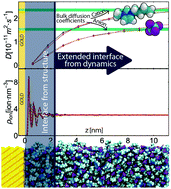
Phys. Chem. Chem. Phys., 2020,22, 10786-10791
https://doi.org/10.1039/D0CP00409J
Li-ion transport at the interface between a graphite anode and Li2CO3 solid electrolyte interphase: ab initio molecular dynamics study
DFT calculation based free energy profile for Li-ion transport across graphite anode/Li2CO3 SEI interface, indicating how to understand the profile change between discharging and charging in battery.
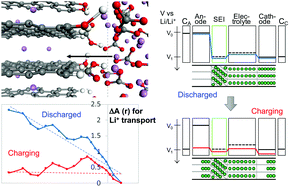
Phys. Chem. Chem. Phys., 2020,22, 10764-10774
https://doi.org/10.1039/C9CP06608J
Unraveling the mechanism of biomimetic hydrogen fuel production – a first principles molecular dynamics study
The Fe2(bdt)(CO)6 [bdt = benzenedithiolato] complex, a synthetic mimic of the [FeFe] hydrogenase enzyme can electrochemically convert protons into molecular hydrogen. The free energy landscape reveals a different mechanism for the biomimetic cycle.

Phys. Chem. Chem. Phys., 2020,22, 10447-10454
https://doi.org/10.1039/C9CP06770A
Adiabatic motion and statistical mechanics via mass-zero constrained dynamics
A symplectic, time-reversible algorithm for adiabatically separated systems that exactly samples the Born–Oppenheimer probability distribution is presented and its numerical efficiency is demonstrated on an orbital-free DFT simulation of solid Na.
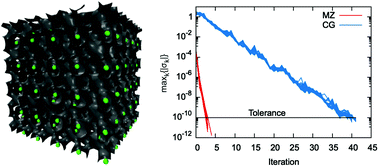
Phys. Chem. Chem. Phys., 2020,22, 10775-10785
https://doi.org/10.1039/D0CP00163E
Effect of anion reorientation on proton mobility in the solid acids family CsHyXO4 (X = S, P, Se, y = 1, 2) from ab initio molecular dynamics simulations
The high temperature phases of the solid acids CsHSeO4, CsHSO4 and CsH2PO4 show extraordinary high proton conductivities, which are enabled by the interplay of high proton transfer rates and frequent anion reorientation.

Phys. Chem. Chem. Phys., 2020,22, 10738-10752
https://doi.org/10.1039/C9CP06473G
Interfacial solvation and slow transport of hydrated excess protons in non-ionic reverse micelles
Simulations show that hydrated excess protons in non-ionic reverse micelles resides near the interface, contrary to some experimental assumptions.
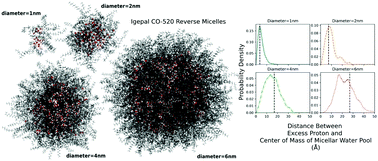
Phys. Chem. Chem. Phys., 2020,22, 10753-10763
https://doi.org/10.1039/D0CP00378F
Glucose in dry and moist ionic liquid: vibrational circular dichroism, IR, and possible mechanisms
The molecular level specification of glucose monomers in ionic liquids and their mixtures with water helps understanding cellulose processing in these liquids.

Phys. Chem. Chem. Phys., 2020,22, 10726-10737
https://doi.org/10.1039/C9CP06798A
Water dynamics at electrified graphene interfaces: a jump model perspective
Changes in water reorientation dynamics at electrified graphene interfaces arise from the interfaces’ impact on water hydrogen-bond exchanges; the asymmetric behavior with electrode potential sign is quantitatively described by an extended jump model.
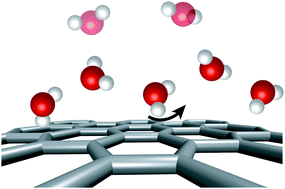
Phys. Chem. Chem. Phys., 2020,22, 10581-10591
https://doi.org/10.1039/D0CP00359J
Modeling interfacial electrochemistry: concepts and tools
This paper presents a grand canonical formalism and provides tools to investigate electrochemical effects at interfaces.
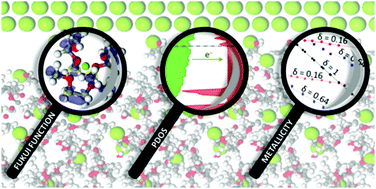
Phys. Chem. Chem. Phys., 2020,22, 10569-10580
https://doi.org/10.1039/C9CP06684E
Polaronic structure of excess electrons and holes for a series of bulk iron oxides
With the use of a gap-optimized hybrid functional and large supercells, it is found that while the electron hole polaron generally localises onto a single iron site, the electron polaron localises across two iron sites of the same spin layer.
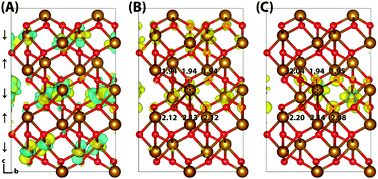
Phys. Chem. Chem. Phys., 2020,22, 10699-10709
https://doi.org/10.1039/C9CP06482F
A first-principles investigation of the structural and electrochemical properties of biredox ionic species in acetonitrile
Ab initio molecular dynamics allow understanding of electron transfer reactions for a series of systems involved in redox supercapacitors.
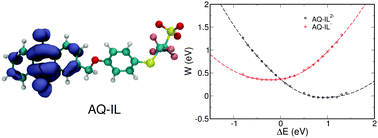
Phys. Chem. Chem. Phys., 2020,22, 10561-10568
https://doi.org/10.1039/C9CP06658F
Spontaneous liquid water dissociation on hybridised boron nitride and graphene atomic layers from ab initio molecular dynamics simulations
By means of ab initio simulations we unveil the high reactivity of boron nitride–graphene planar heterostructure immersed in liquid water: an interfacial water molecule is found to spontaneously chemisorb and deprotonate at one composite border.
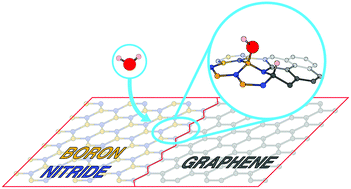
Phys. Chem. Chem. Phys., 2020,22, 10710-10716
https://doi.org/10.1039/C9CP06765E
Enhanced conductivity of water at the electrified air–water interface: a DFT-MD characterization
DFT-based molecular dynamics simulations of the electrified air–liquid water interface are presented, where a homogeneous field is applied parallel to the surface plane (i.e. parallel to the 2D-HBonded-Network/2DN).
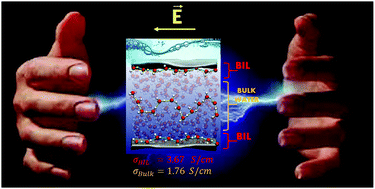
Phys. Chem. Chem. Phys., 2020,22, 10438-10446
https://doi.org/10.1039/C9CP06970D
Carbon dioxide, bicarbonate and carbonate ions in aqueous solutions under deep Earth conditions
We investigate the effect of pressure, temperature and acidity on the composition of water-rich carbon-bearing fluids under thermodynamic conditions that correspond to the Earth's deep crust and upper mantle.
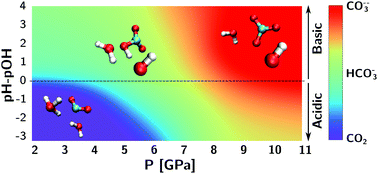
Phys. Chem. Chem. Phys., 2020,22, 10717-10725
https://doi.org/10.1039/C9CP06904F
Revisiting nuclear tunnelling in the aqueous ferrous–ferric electron transfer
We find that golden-rule quantum transition-state theory predicts nearly an order of magnitude less tunnelling than some of the previous estimates. This may indicate that the spin-boson model of electron transfer is not valid in the quantum regime.
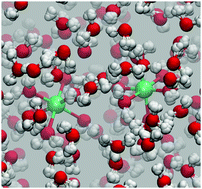
Phys. Chem. Chem. Phys., 2020,22, 10687-10698
https://doi.org/10.1039/C9CP06841D
Aqueous solvation of the chloride ion revisited with density functional theory: impact of correlation and exchange approximations
Aqueous chloride is simulated using PBE-D3, PBE0-D3, and SCAN to investigate the impact of exchange and correlation approximations; we find the exact exchange fraction strongly impacts the energetics and polarizability of solvated chloride.
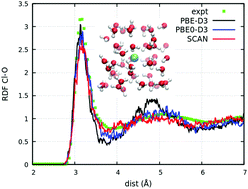
Phys. Chem. Chem. Phys., 2020,22, 10666-10675
https://doi.org/10.1039/C9CP06821J
Electromechanics of the liquid water vapour interface
The response of the anisotropic stress at the liquid water vapor interface to a finite electric suggests that the surface potential of water can be seen as an electro-capillary effect coupled to the Maxwell stress tensor.
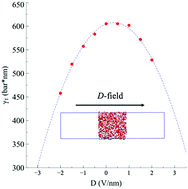
Phys. Chem. Chem. Phys., 2020,22, 10676-10686
https://doi.org/10.1039/C9CP06901A
Revisiting the Volmer–Heyrovský mechanism of hydrogen evolution on a nitrogen doped carbon nanotube: constrained molecular dynamics versus the nudged elastic band method
This study presents the first direct simulation of the hydrogen evolution reaction using a fully explicit, dynamic DFT approach and highlights the importance of incorporating solvent dynamics in the rigorous description of electrochemical reactions.
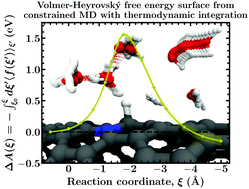
Phys. Chem. Chem. Phys., 2020,22, 10536-10549
https://doi.org/10.1039/C9CP06474E
Ionization energies in solution with the QM:QM approach
Fragment-based QM:QM technique provides an efficient and accurate way for calculating energetics of vertical processes such as ionization.
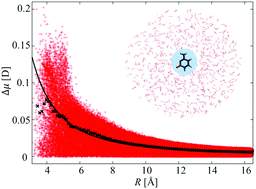
Phys. Chem. Chem. Phys., 2020,22, 10550-10560
https://doi.org/10.1039/C9CP06154A
Water structures on a Pt(111) electrode from ab initio molecular dynamic simulations for a variety of electrochemical conditions
Water structures on a Pt(111) metal electrode critically depend on the electrochemical conditions, as shown by ab initio molecular dynamics simulations.
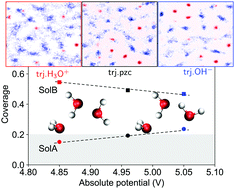
Phys. Chem. Chem. Phys., 2020,22, 10431-10437
https://doi.org/10.1039/C9CP06584A
Exciton transfer free energy from Car–Parrinello molecular dynamics
Free energies profiles for exciton transfer processes are calculated within ab initio molecular dynamics by applying restraining potentials to the Wannier centres of molecular orbitals corresponding to an electron-hole pair.
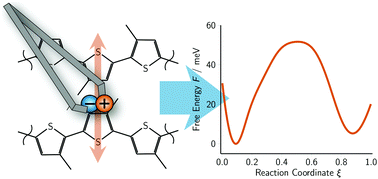
Phys. Chem. Chem. Phys., 2020,22, 10526-10535
https://doi.org/10.1039/C9CP06419B
Benchmark and performance of long-range corrected time-dependent density functional tight binding (LC-TD-DFTB) on rhodopsins and light-harvesting complexes
In the present work, we perform a benchmark study on both the isolated chromophores retinal and BChl a as well as on the biological systems, to determine the accuracy of LC-TD-DFT and LC-TD-DFTB for describing color-tuning effects.
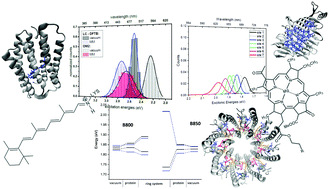
Phys. Chem. Chem. Phys., 2020,22, 10500-10518
https://doi.org/10.1039/C9CP05753F
Quantum kinetic energy and isotope fractionation in aqueous ionic solutions
Decomposition of the quantum kinetic energy and isotope fractionation ratios uncovers the local solvation structures in aqueous ionic solutions.
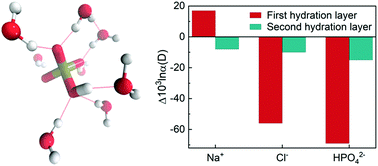
Phys. Chem. Chem. Phys., 2020,22, 10490-10499
https://doi.org/10.1039/C9CP06483D
Electron transfer in nonpolar media
Electron transfer in nonpolar media violates the temperature scaling predicted by the fluctuation–dissipation theorem.
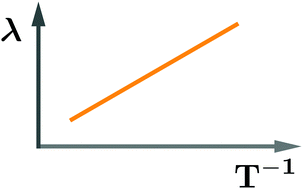
Phys. Chem. Chem. Phys., 2020,22, 10653-10665
https://doi.org/10.1039/C9CP06166E
Quantifying the hydration structure of sodium and potassium ions: taking additional steps on Jacob's Ladder
The ability to reproduce the experimental structure of water around the sodium and potassium ions is a key test of the quality of interaction potentials due to the central importance of these ions in a wide range of important phenomena.

Phys. Chem. Chem. Phys., 2020,22, 10641-10652
https://doi.org/10.1039/C9CP06161D
Rapid and accurate molecular deprotonation energies from quantum alchemy
Deprotonation energies calculated from alchemical electron density derivatives.
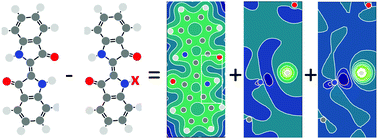
Phys. Chem. Chem. Phys., 2020,22, 10519-10525
https://doi.org/10.1039/C9CP06471K
Charge fluctuations from molecular simulations in the constant-potential ensemble
Statistical mechanics of constant-potential molecular simulations yields a new fluctuation–dissipation relation for the differential capacitance.
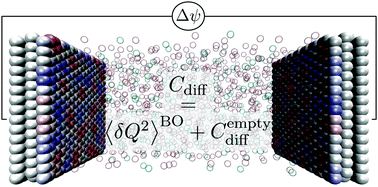
Phys. Chem. Chem. Phys., 2020,22, 10480-10489
https://doi.org/10.1039/C9CP06285H
Assessing the properties of supercritical water in terms of structural dynamics and electronic polarization effects
Evolution of water's structural dynamics from ambient liquid to supercritical dense liquid-like and dilute gas-like conditions.
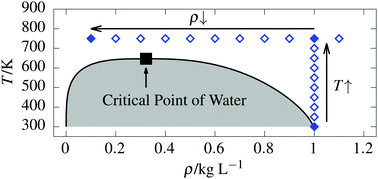
Phys. Chem. Chem. Phys., 2020,22, 10462-10479
https://doi.org/10.1039/C9CP05610F
Thermodynamics of the formation of surface PtO2 stripes on Pt(111) in the absence of subsurface oxygen
This paper examines the thermodynamics of PtO2 stripes formed as intermediates of Pt(111) surface oxidation as a function of the degree of dilation parallel to the stripes, using density functional theory and atomistic thermodynamics.
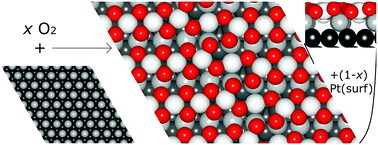
Phys. Chem. Chem. Phys., 2020,22, 10634-10640
https://doi.org/10.1039/C9CP05107D
The Lennard-Jones potential: when (not) to use it
The Lennard-Jones 12-6 potential is widely used in simulations… or is it? We propose reconsidering when to use it.
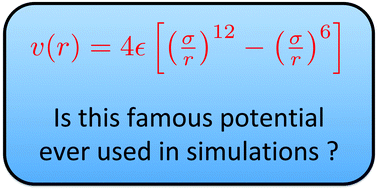
Phys. Chem. Chem. Phys., 2020,22, 10624-10633
https://doi.org/10.1039/C9CP05445F
Electron transfer in extended systems: characterization by periodic density functional theory including the electronic coupling
CP2K implementation describing electron transfer in extended systems treated by periodic-DFT, including the calculation of electronic coupling transition element VAB.
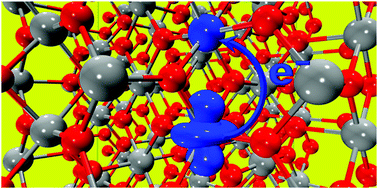
Phys. Chem. Chem. Phys., 2020,22, 10609-10623
https://doi.org/10.1039/C9CP05133C
Site dependent reactivity of Pt single atoms on anatase TiO2(101) in an aqueous environment
The TiO2–Pt–water interface is of great relevance in photocatalysis where Pt is widely used as a co-catalyst for enhancing hydrogen evolution in aqueous TiO2.
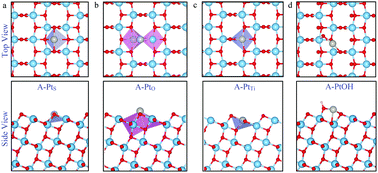
Phys. Chem. Chem. Phys., 2020,22, 10455-10461
https://doi.org/10.1039/C9CP05097C
Interactions of ions across carbon nanotubes
The interactions between a pair of ions across CNTs have been investigated by DFT. The electrostatic field of the ion is almost completely screened outside of the tube but an effective attraction between the ions has arisen.
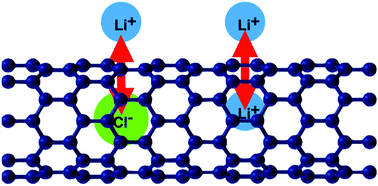
Phys. Chem. Chem. Phys., 2020,22, 10603-10608
https://doi.org/10.1039/C9CP04463A
About this collection
Predictive molecular simulation of condensed matter at finite temperature has come a long way from the first practical implementations of ab-initio or Car-Parrinello molecular dynamics thirty years ago.
This themed collection provides a representative snapshot of latest and upcoming techniques and their applications at the forefront of this research area with a specific focus on the simulation of solvated ions, molecules and interfaces.
Guest Edited by: Jochen Blumberger (University College London), Marie-Pierre Gaigeot (Université d’Evry val d’Essonne and Université Paris-Saclay), Marialore Sulpizi (Johannes Gutenberg Universität Mainz) and Rodolphe Vuilleumier (Sorbonne University).